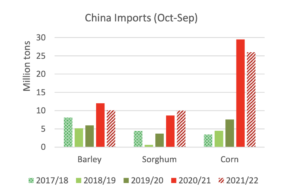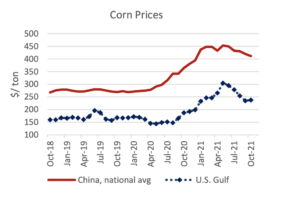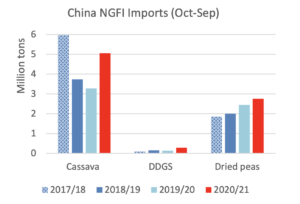The USDA is projecting that the ag trade deficit will shrink in FY2026 even more than previously anticipated. USDA expects the trade deficit to fall from $43.7 billion in FY2025…
China’s Coarse Grain Imports for 2020/21, Doubles the Previous Record
Earlier this week, in its Grain: Worlds Market and Trade report, the USDA’s Foreign Agricultural Service (FAS) stated that, “China coarse grain imports for 2020/21 are now complete.
Based on China Customs’ data, combined imports of corn, sorghum, and barley from the world totaled 50.2 million tons, doubling the previous record set in 2014/15.
“Imports of corn and barley each reached new highs, while sorghum reached the second-largest volume on record. Major suppliers for corn were the United States (69 percent) and Ukraine (29 percent); for sorghum, the United States (77 percent) and Argentina (14 percent); for barley, Canada (29 percent), France (26 percent), and Ukraine (26 percent).”

FAS added that, “The import growth can be attributed to a convergence of events. Aside from the implementation of the U.S.- China Phase One agreement, the recovery in the swine sector from African swine fever favored the use of corn in feed rations and drove domestic corn prices higher. The run-up in prices widened the spread between imports and domestic corn, making imports highly profitable.

“Higher prices also boosted imports of sorghum and barley. These corn substitutes are not genetically modified, making imports and use less administratively burdensome. Since June, domestic corn prices have declined but are still above a year ago despite expectations of a record harvest this fall.”
The FAS report also pointed out that, “Imports of non-grain feed ingredients (NGFI) also grew from the prior year. Strong cassava imports can be attributed to high domestic corn prices as feed mills and fuel ethanol plants may have turned to a cheaper alternative to domestic corn. Imports of distillers’ dried grains (DDGS) improved from a year ago but were small as the antidumping and countervailing duties on U.S. DDGS remain in place.

“Imports of dried peas, used as a protein source in feed rations, continued to set new highs.”





